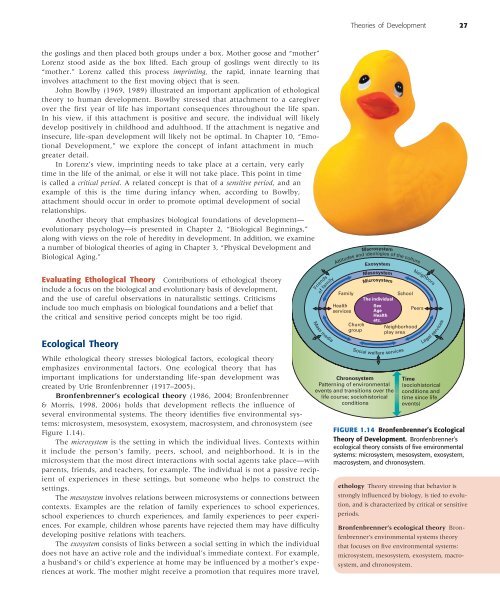Research in Life-Span Development
Research in Life-Span Development
Research in Life-Span Development
You also want an ePaper? Increase the reach of your titles
YUMPU automatically turns print PDFs into web optimized ePapers that Google loves.
the gosl<strong>in</strong>gs and then placed both groups under a box. Mother goose and “mother”<br />
Lorenz stood aside as the box lifted. Each group of gosl<strong>in</strong>gs went directly to its<br />
“mother.” Lorenz called this process impr<strong>in</strong>t<strong>in</strong>g, the rapid, <strong>in</strong>nate learn<strong>in</strong>g that<br />
<strong>in</strong>volves attachment to the fi rst mov<strong>in</strong>g object that is seen.<br />
John Bowlby (1969, 1989) illustrated an important application of ethological<br />
theory to human development. Bowlby stressed that attachment to a caregiver<br />
over the fi rst year of life has important consequences throughout the life span.<br />
In his view, if this attachment is positive and secure, the <strong>in</strong>dividual will likely<br />
develop positively <strong>in</strong> childhood and adulthood. If the attachment is negative and<br />
<strong>in</strong>secure, life-span development will likely not be optimal. In Chapter 10, “Emotional<br />
<strong>Development</strong>,” we explore the concept of <strong>in</strong>fant attachment <strong>in</strong> much<br />
greater detail.<br />
In Lorenz’s view, impr<strong>in</strong>t<strong>in</strong>g needs to take place at a certa<strong>in</strong>, very early<br />
time <strong>in</strong> the life of the animal, or else it will not take place. This po<strong>in</strong>t <strong>in</strong> time<br />
is called a critical period . A related concept is that of a sensitive period , and an<br />
example of this is the time dur<strong>in</strong>g <strong>in</strong>fancy when, accord<strong>in</strong>g to Bowlby,<br />
attachment should occur <strong>in</strong> order to promote optimal development of social<br />
relationships.<br />
Another theory that emphasizes biological foundations of development—<br />
evolutionary psychology—is presented <strong>in</strong> Chapter 2, “Biological Beg<strong>in</strong>n<strong>in</strong>gs,”<br />
along with views on the role of heredity <strong>in</strong> development. In addition, we exam<strong>in</strong>e<br />
a number of biological theories of ag<strong>in</strong>g <strong>in</strong> Chapter 3, “Physical <strong>Development</strong> and<br />
Biological Ag<strong>in</strong>g.”<br />
Evaluat<strong>in</strong>g Ethological Theory Contributions of ethological theory<br />
<strong>in</strong>clude a focus on the biological and evolutionary basis of development,<br />
and the use of careful observations <strong>in</strong> naturalistic sett<strong>in</strong>gs. Criticisms<br />
<strong>in</strong>clude too much emphasis on biological foundations and a belief that<br />
the critical and sensitive period concepts might be too rigid.<br />
Ecological Theory<br />
While ethological theory stresses biological factors, ecological theory<br />
emphasizes environmental factors. One ecological theory that has<br />
important implications for understand<strong>in</strong>g life-span development was<br />
created by Urie Bronfenbrenner (1917–2005).<br />
Bronfenbrenner’s ecological theory (1986, 2004; Bronfenbrenner<br />
& Morris, 1998, 2006) holds that development refl ects the <strong>in</strong>fl uence of<br />
several environmental systems. The theory identifi es fi ve environmental systems:<br />
microsystem, mesosystem, exosystem, macrosystem, and chronosystem (see<br />
Figure 1.14 ).<br />
The microsystem is the sett<strong>in</strong>g <strong>in</strong> which the <strong>in</strong>dividual lives. Contexts with<strong>in</strong><br />
it <strong>in</strong>clude the person’s family, peers, school, and neighborhood. It is <strong>in</strong> the<br />
microsystem that the most direct <strong>in</strong>teractions with social agents take place—with<br />
parents, friends, and teachers, for example. The <strong>in</strong>dividual is not a passive recipient<br />
of experiences <strong>in</strong> these sett<strong>in</strong>gs, but someone who helps to construct the<br />
sett<strong>in</strong>gs.<br />
The mesosystem <strong>in</strong>volves relations between microsystems or connections between<br />
contexts. Examples are the relation of family experiences to school experiences,<br />
school experiences to church experiences, and family experiences to peer experiences.<br />
For example, children whose parents have rejected them may have diffi culty<br />
develop<strong>in</strong>g positive relations with teachers.<br />
The exosystem consists of l<strong>in</strong>ks between a social sett<strong>in</strong>g <strong>in</strong> which the <strong>in</strong>dividual<br />
does not have an active role and the <strong>in</strong>dividual’s immediate context. For example,<br />
a husband’s or child’s experience at home may be <strong>in</strong>fl uenced by a mother’s experiences<br />
at work. The mother might receive a promotion that requires more travel,<br />
Friends<br />
of family<br />
Mass media<br />
Family<br />
Health<br />
services<br />
Theories of <strong>Development</strong> 27<br />
Attitudes and ideologies of the culture<br />
Church<br />
group<br />
Macrosystem<br />
Exosystem<br />
Mesosystem<br />
Microsystem<br />
The <strong>in</strong>dividual<br />
Chronosystem<br />
Pattern<strong>in</strong>g of environmental<br />
events and transitions over the<br />
life course; sociohistorical<br />
conditions<br />
School<br />
Neighbors<br />
Sex<br />
Peers<br />
Age<br />
Health<br />
etc.<br />
Neighborhood<br />
play area<br />
Social welfare services<br />
Legal services<br />
Time<br />
(sociohistorical<br />
conditions and<br />
time s<strong>in</strong>ce life<br />
events)<br />
FIGURE 1.14 Bronfenbrenner’s Ecological<br />
Theory of <strong>Development</strong>. Bronfenbrenner’s<br />
ecological theory consists of fi ve environmental<br />
systems: microsystem, mesosystem, exosystem,<br />
macrosystem, and chronosystem.<br />
ethology Theory stress<strong>in</strong>g that behavior is<br />
strongly <strong>in</strong>fl uenced by biology, is tied to evolution,<br />
and is characterized by critical or sensitive<br />
periods.<br />
Bronfenbrenner’s ecological theory Bronfenbrenner’s<br />
environmental systems theory<br />
that focuses on fi ve environmental systems:<br />
microsystem, mesosystem, exosystem, macrosystem,<br />
and chronosystem.

















